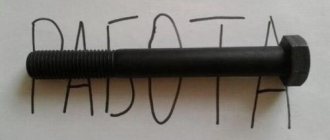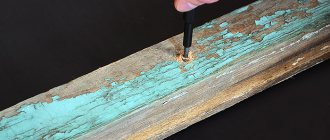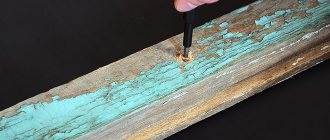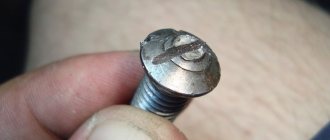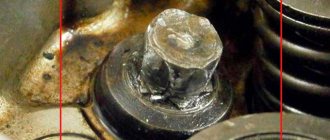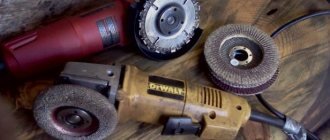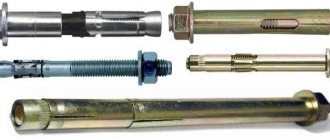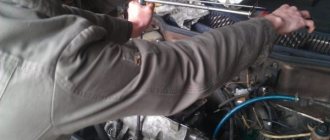How to unscrew nuts and bolts if they won't come off. If there is any doubt that the nut can be unscrewed with an open-end wrench, we immediately take a socket or socket. As soon as we feel that the nut begins to break off (the wrench turns), we immediately stop this action and move on to the next alternative method.
1-knock with a hammer (knock the bolt or nut several times with a hammer and then try to unscrew it)
2-liquid key (or as it is called WD liquid spray)
3-chisel (chisel and hammer. A very effective way, chisel along the edge of the nut or bolt in the direction of unscrewing. It should unscrew)
4-heating (if possible, for example with a torch, if the part is small, then you can throw it into the fire, but you need to understand that if there are some kind of rubber seals on the part, etc., you can’t throw it into the fire)
5-weld a key to the nut and twist. (Weld a pipe or something else to the bolt and twist)
6-bolgarka (the nut will be damaged, but the bolt will remain more or less out of alignment)
7-sawing for a screwdriver (when unscrewing a hinge, for example a steering knuckle, a ball joint, a stabilizer strut or something similar, if the nut rotates with the bolt, that is, the ball rotates, then you can cut a groove in the bolt for a screwdriver, hold the bolt with a screwdriver and twist the nut)
8-Realistic-Unrealistic method (a chemical that corrodes steel or liquid nitrogen, the nut will most likely be destroyed).
If you don’t need to unscrew it, but just need to break it, you can use a drill, a large sledgehammer, or special scissors for cutting steel.
How to unscrew a broken bolt?
Basic methods:
- Clean the surface with a metal brush and treat it with diesel fuel or kerosene. They try to unscrew the nut with a spanner. Although there is no absolute guarantee that it will unscrew.
- Using a chisel and hammer, strike in the direction of unscrewing. This method is not suitable for a small nut.
- A gas wrench with a powerful clamp is a good tool in this situation. It is easy for them to grab even round objects, but it is harder in hard-to-reach places. The longer the handle, the easier it is to unscrew.
- When the fastening material is large and difficult to unscrew, you can use welding equipment to apply a metal coating and prepare the desired turnkey shape with a file.
- Use a drill to cut out a hole inside the body of the fastening element, thread an L-shaped rod through it, which will serve as a handle, and remove it.
When there is enough space to use an adjustable wrench or pliers, this is good, but what to do in other situations?
How to unscrew a hex or sprocket head bolt
To remove the element use a gas wrench to compress the part, make a cut on the head with a grinder and unscrew it with a screwdriver, an extractor of the appropriate size, or special tools (wrench, pin driver), which are beneficial to purchase only if you have to deal with such problems quite often.
Select the TORX sprocket according to size (it should not be large and the slots should fit into the hole for the hexagon). It is inserted tightly into the head and the bolt is jerkily unscrewed to avoid the sprocket spline from breaking off. When driving sprockets with holes in the center, they break off, so their use is not recommended.
Any hardware or auto store sells sets of extractors . Externally, this device looks like a metal rod with a conical thread on the left side and a faceted base on the right. They are used to unscrew nuts with torn edges. To do this, drill a hole strictly in the center of the bolt, drive an extractor of the required size into it and unscrew it with pliers. This is done simply and quickly, because the extractor has the opposite cutting.
A drill with reverse is an irreplaceable thing. Use a thin drill to make a hole near the bolt. Take a left-hand rotation drill with a smaller diameter and drill out the damaged bolt in inverse rotation mode.
JayBee › Blog › Unscrew overtightened, rotted or licked bolts.
How to unscrew a drain/fill plug that won't come off? I don’t know about you, but I’ve encountered this problem more than once when I was unscrewing screw plugs that stupid people had tightened from pallets, gearboxes, transfer cases and gearboxes. There are different situations, sometimes the cut of the bolt is already licked off from the outside, sometimes the hexagon inside is turned, sometimes nothing is licked off, but it gets licked off when you start to twist, and it gets licked off because when you tightened it, you tightened it tightly, but not so much as to spoil the head of the bolt - the plug, but to unscrew it you need more force, since in addition to the tightening torque, diffusion, sticking and corrosion of the bolt head are added over time. As practice shows, classical methods like heating, spraying with penetrating lubricant, unscrewing with pliers and all that nonsense usually do not help. And of course there are still several ways. Everyone knows that you can drill out using a drill of a slightly smaller diameter, and then catch the sawdust with a magnet. But this is cruel and inconvenient, you can damage the threads in the unit, and in general it is not always possible. Of the methods that not everyone has tried, I can offer a couple of my own. Moreover, these methods are applicable to all generally licked, overtightened and other bolts that should not be drilled.
Method one - if the bolt head is not quite tiny, instead of large gas wrenches and pliers, it is better to immediately try this method. You need to put a small vise or clamp on the bolt and tighten it as much as possible. It will hold on much better than any key, but you can try to unscrew it using this clamp.
The easiest way - I recently practiced it again - is a hammer and a punch, a large screwdriver, a blunt chisel or something like that. It is especially effective when the internal hexagon of a round plug with a thin head is rolled up, as on gearboxes, for example. Take a hammer and what you will hit with it, press it against the edge of the head of the bolt so that hitting the chisel (or other tool) rotates the plug counterclockwise. And of course, the chisel must be kept as close as possible to the tangent circle. Why is it better to use something blunt? Because a sharp one usually begins to cut the cork, and a blunt one is easier to turn it on. The method works, verified. Replacement bolt.
And finally, the most cunning, and at the same time simplest method, one might say my signature one.
Although, of course, it is mainly applicable to bolts made of ferrous metals. You need to clean the surface of the licked or overtightened bolt and weld a piece of metal to it, which will be easier to unscrew. I did it differently. for example, you can immediately weld a pipe, you can weld a larger bolt, the main thing is to weld it well. You can burn a hole in the cork with an electrode, and burn it, and not drill it, so that it is not round, insert a rod with a non-circular cross-section, or anything that will not rotate freely in the hole, and scald it.
and of course, if the cap is not small, you can truncate the circle with a couple of edges for a wrench or a clamp, you can drill a couple of holes on the opposite edges of the plug and weld in a bolt, which can then be unscrewed.
In general, don't despair. There is always some kind of backup option, the main thing is not to damage the unit. And of course, you can remove the pan and drain everything (if it’s a pan plug), you can drain it, remove the oil filter, if it’s from below, blow out the remaining oil with air, you can suck it out through the filler, if the filler in the box does not give in, you can pour it through the dipstick, you can unscrew the speed or reverse gear sensor from the box, but of course the best option is not to tighten all this crap. Of course, I don’t suggest turning all this with a torque wrench, but you need to remember that you don’t need to lean, you need to tighten them by hand with a wrench or a small ratchet, and don’t forget to replace the soft metal washer-spacer after unscrewing. Don't be afraid that something will get out. I've encountered passengers so strong that the pan on a V8 cruiser bent when I unscrewed the drain plug.
If the bolt head breaks off
In this case, you need to be patient and choose the appropriate course of action.
Three ways:
- Drill a hole 3 cm smaller than the diameter of the bolt and screw a tap with a left-hand thread into it until the broken part begins to unscrew.
- If part of the bolt protrudes, then you can make a cut on it using a grinder under a slotted screwdriver and begin unscrewing it.
- A hole is made in the base into which the extractor is screwed counterclockwise. Then the damaged element is removed with a key.
The process takes several minutes, but there are products with a countersunk hexagon head, the edges of which are easily torn off. A Torx of the appropriate size will help to cope with this problem.
How to drill out a broken bolt
Professionals advise using a small-diameter drill and making sure that it does not tilt to the sides when working. When purchasing, you need to focus on the country of origin and cost. High-quality drills cannot be cheap; they are sharpened in a special way and made of hardened steel.
Unscrewing the nuts and bolts is done slowly and consistently ; in this case, you cannot rush, otherwise unforeseen problems will arise later and a loss of time to eliminate them. For example, many auto repairmen rush to unscrew rusty bolts that break. A lot of time is wasted fixing errors. Therefore, it is necessary to immediately plan the course of action. We will discuss how to deal with rusty bolts further.
Basics of Proper Drilling
Drilling is usually used as a last resort, when no other tools can help in the situation that has arisen. The main condition for using a drill is that the bolt should not be hardened. Before attempting to drill out a broken piece of hardware, it is worth trying other extraction methods.
A stud with a small diameter is drilled out with a very narrow drill. Two opposite holes are made on the fragment to a depth of 10 mm. Then they try to unscrew the bolt using narrow-nose pliers or two nails. Nails need to be inserted into the holes, clamped with pliers and twisted.
The solid metal reverse thread cone drill bit is also suitable for efficient and correct drilling. The extractor is screwed into the center of the hardware and the fragment is removed.
Drilling directly with a drill is a difficult option that requires utmost attention. You will need several sharp drills of different sizes. It is important to accurately determine the center. A core will help with this. Use the smallest drill to drill the bolt. You need to drill evenly along the entire length of the fragment. The narrow hole is re-passed with a thicker drill. The closer the edge of the hole is to the walls, the better. Using a screwdriver or chisel, scrape off the residue inward and then remove it outward.
A broken bolt stuck in a structure has long ceased to be a problem. There are many effective and proven ways to remove fasteners. First of all, you need to assess the nature of the breakdown, its cause, and then select the appropriate method. For such a case, you may need a variety of tools - from a simple adjustable wrench to solid metal drills.
How to unscrew a stuck bolt
Car repairs are often made more difficult due to corrosion and oxidation of fasteners. For example, during assembly at the factory, the master did not treat the threads with lubricants, and during operation water got in there. As a result, the bolt seemed to be stuck tightly, but such a nuisance can be dealt with in several ways.
Unscrew a rusty bolt or nut by tapping
, rust and scale come off the bolt , so it becomes easier to unscrew it. The operation is carried out with a hammer, turning with a special tool to create torque. Be careful, as you can damage the product and have to drill it out. After removing the fastener, it is cleaned of rust and treated with graphite lubricant. If available, place a boot on the connection.
Using solvents
In the arsenal of any experienced car enthusiast there is always a set of liquids to combat rust and other deposits. They mainly use WD-40 with good penetrating ability into micro-gaps, the cost of which starts from 100 rubles . Along with it, brake fluid, white spirit, kerosene, and Coca-Cola are used. Unlike WD-40, other liquids have a weaker effect, and it is better to pour them into a container and place the stuck compound in it for greater effect.
Read also: Drill blade for hammer drill
If the bolt is stuck on the front pillar, the solvent can be carefully poured into the “glass”. The main thing is not to damage the rubber bands on the racks, otherwise you will have to change them.
Moisten a rag with any product, wrap it around the nut and leave it for a while. Then they tap the bolt to destroy the softened rust and begin to unscrew it.
Thermal method
When the solvent does not cope with the task, you can try exposure to fire and cold . Any large auto or hardware store sells a gas torch; it is used to heat the bolt until it turns bright orange. Then they cool it with machine oil and try to weaken it. If the attempt fails, the process is repeated again.
This method does not always help, and if it is close to the paintwork or fuel tank it is very dangerous. When working with a gas burner, you must follow fire safety rules and do not use it if you do not have a fire extinguisher at hand.
Use freezing sprays to preserve the bolt for later use. But such reagents are mainly used by professionals, since in domestic conditions this is a costly and unprofitable matter .
How to unscrew a licked bolt
When turning the bolt, pry it up with a nail puller and pull it out to the maximum possible height, leave it in tension and gradually unscrew it with a wrench. When you don't have a nail puller, you can use a screwdriver. A small bolt is removed using pliers by the head. If it does not give in immediately, then rotate it, clamping it with pliers counterclockwise with upward force.
Use a tap and insert it all the way. If you don’t have it at hand, then a screwdriver with a cone-shaped edge will do, which you carefully hammer in until it stops and try to unscrew it.
To prevent such situations from reoccurring, they must be treated with graphite lubricant before tightening the bolts. But solid oil or lithol are not used for this purpose, because they are used for rubbing parts, and after lubrication, bolted joints become jammed with them.
Before defeating “stubborn” fasteners, it is worthwhile to carefully understand what a bolted connection is, in principle?
A bolt is a fastening element in the form of a threaded rod and a hexagonal head. It serves to transmit torque from the tool to the threaded rod when unscrewing/tightening the bolt. In turn, the threaded part (bolt shaft) is inserted into the hole of the parts being fastened. And it can either go out - then to fasten and tighten the parts, a nut is put on the end of the rod (with or without a washer, a spring washer or a pack of washers, or a locknut can also be used). Or the bolt can be screwed into a through or blind hole with internal threads. Then a nut is not required, although a washer can again be placed under the hex head of the bolt - to prevent the fastener from loosening during operation and/or to protect the surface of the part from damage during the initial tightening of the fastener.
Of course, in practice there are a variety of bolted connections. However, the tightening of the bolt is always ensured by tightly pressing the protrusions of its thread (external - on the rod) to the protrusions of the mating internal thread of the nut or hole in the body of the part.
Where is anti-vandal fastener useful?
It is often used outdoors, so a stainless steel anti-vandal screw or self-tapping screw is ideal for such places of use.
Here is a far from complete list of places where anti-vandal fasteners are still used:
- interior design of elevators
- intercoms
- signs and signs on the walls of houses
- playgrounds
- Appliances
- removable sections of fences and barriers
- car plate numbers
- advertising designs
"Attention!
Remember that anti-vandal fasteners will only protect your product from spontaneous theft and hacking.” Stainless steel anti-vandal fasteners in TsKI mean ease of installation, always excellent appearance and safety of the equipment.
More details about the assortment can be found in the catalog
Choose the right fasteners!
Why doesn't he spin?
From the above it follows that to tighten or unscrew a bolt you need to apply a certain force. This is called the tightening torque. This value is very important for the normal functioning of products. And strictly speaking, the assembly instructions always indicate the recommended tightening torque for bolts (as well as nuts and studs, if any). Which must be observed when using a torque wrench!
When tightening, torque is applied to the bolt through its hex head. Therefore, both for tightening and unscrewing, the head must be in good working order (in fact, present - after all, there are bolts with a broken head!), have smooth, not torn edges, and be suitable in size for the existing tool (although, of course, this tool is chosen suitable for the bolt, and not vice versa).
Logically, when unscrewing a bolt, you need to apply the same force as when tightening it? But no! During operation, the bolted connection is prone to self-tightening (although spontaneous loosening also occurs, but this is a separate topic!). And rust and dirt that gets on the threads lead to souring of the connection. So unscrewing an old bolt is much more difficult than screwing in a new one!
This is where the extra torque is needed. However, it is not always possible to transfer it to the rod and successfully unscrew the bolt. How to unscrew a bolt for various defects is indicated below.
Demountable anti-vandal fasteners
The main principle is to make either the slot itself or access to it as difficult as possible, so that a standard standard tool is not suitable for unscrewing or dismantling.
Quite a lot of variants of such splines have already been created, and new ones appear periodically.
We offer the most popular anti-vandal screws and self-tapping screws TORX TR, as well as bits for them.
Various types of plugs can be used to close the slot. Here is, for example, a ball for HEX and TORX slots:
How to unscrew a bolt with a broken head?
Did the previous would-be master apply too much force when tightening and break the head? Or the head fell off during the first attempt to unscrew an old, rusted or “overworked” bolt.
In any case, the rod sticking out in the body of the part needs to be unscrewed somehow. The most “painless” way is to use a special “extractor” tool. Essentially, it is a short rod with a tapered (left-handed!) thread at the end and a hex thread in the middle. A shallow hole is drilled in the broken shaft of the stuck bolt, an extractor is inserted, a key is grabbed onto its hexagon and rotated to the left. Using a conical thread, the extractor “bites” into the body of the bolt and pulls it along with it to the left - that is, it unscrews it. Using an extractor, you can not only unscrew a bolt with a broken head, but also one with stuck threads.
Permanent anti-vandal fastener
There are two main ways to ensure that fasteners become permanent:
Used to tear off the mounting element
The detachment of the mounting element occurs when the required tightening torque is reached, after which there is simply nothing to unscrew.
Breakaway nuts are used (they are also called breakaway nuts and breakaway bolts (they are also breakaway screws, or bolts with a breakaway head). Both are presented in our assortment:
- Unidirectional spline
You can screw it in, but you can’t unscrew it - the screwdriver or head will pop out or turn. Our assortment includes screws and self-tapping screws with semicircular and countersunk heads with a one-sided slot One Way.
"Attention! To tighten such fasteners, you do not need a special tool - just a screwdriver or a straight bit, or an object that can replace them!
Torn edges of the head
How to unscrew a bolt with torn edges? This is a little easier than the previous case - after all, the bolt remains intact, it’s just that the key cannot be securely hooked onto the head.
In this case, instead of an open-end wrench, you can use a spanner wrench - it will prevent the head from being damaged even more. If the edges are severely torn off, so that even the head “turns”, you need to “file” new edges using a file - this is not as difficult as it seems.
Another way: weld a new nut to the head of a bolt with torn edges. And then unscrew the bolt, clinging the key to it. This method is reliable, but labor-intensive (welding is required) and is not always appropriate.
Read also: Replacing the bearing on a Makita grinder
Selection and acquisition
When purchasing anti-vandal screws with a semicircular head or any other configuration, it is necessary to focus not only on the design features, but also on the ease of installation, purpose, possibility of dismantling, and the degree of protection from negative factors.
You should contact a reputable and reliable manufacturer. Such companies provide a guarantee and help with the choice.
For example, to install a fence, anti-vandal self-tapping screws made of high-strength stainless steel are used. They not only have high technical performance, but also do not violate the aesthetics of the appearance.
How to unscrew a bolt with stripped threads?
Probably the main reason why it is difficult to remove a bolt is stuck, rusted or damaged threads. The first two reasons appear during operation, but threads can easily be stripped during the installation process - tightening the bolt. Or just when unscrewing, if the dirty thread creates significant resistance, and the impatient master makes too much effort.
If the threads are stripped and the bolt is located in a hard-to-reach place, unscrewing it can turn into quite a problem!
To remove a small bolt, you need to try, loosen it slightly, insert a pair of pliers under the head and pull it out, like a nail from a board.
For larger bolts, you will need a screwdriver and a nail puller: try to slide the screwdriver under the head of the bolt. And, tapping this “lever” with a hammer, at least slightly pull the damaged bolt out of the body of the part. Then you can put a nail puller under the head and again, like a nail, “uproot” the bolt.
However, during such an operation, excessive force must be avoided! After all, if the bolt is new, but the thread is broken during installation, it’s one thing. What if the carving has collapsed over time? Then “uprooting” the bolt may result in a broken head. And the master will be faced with the question “how to unscrew a broken bolt?”, which we considered at the very beginning.
Installation subtleties
Self-tapping screws and anti-vandal stainless bolts for fences are very popular. They can be used both in large enterprises and in public places and in the home. Installation is distinguished by the presence of several important rules, which include the following aspects:
- screwing occurs along the line of the transverse joists, after which the elements are welded;
- installed together with breakaway nuts;
- work requires special tools for sprocket, hexagon, hidden heads, etc.
Vandal-proof stainless steel fence bolts retain their original properties for many years, are easy to unscrew if necessary and do not require any maintenance.
How to unscrew a stuck bolt?
“Stuck” (seized by dirt and/or rusted) threads can be absolutely serviceable (not torn off). But due to the presence of dirt or rust in its depressions, the bolt is “clamped in a vice.” And excessive force to unscrew it can just lead to thread failure! Which is undesirable, since eliminating “sticking” and still removing a serviceable bolt is much easier than eliminating a broken thread.
Therefore, before sinning to damage the bolt and resorting to forceful methods of “uprooting”, it is better to first try to eliminate sticking. To do this, you should use (required!) a socket wrench or a socket head. An open-end wrench can only tear off the edges or even tear off the bolt head! (how to unscrew a broken bolt is discussed at the beginning of the article)
However, before “turning” the wrench, you should, firstly, thoroughly clean the bolt from adhering dirt. And secondly, treat it with a special liquid. The best choice is one that contains molybdenum disulfate. Penetrating all-purpose lubricant WD-40 will also work. As a last resort, you can use kerosene, brake fluid or diesel fuel (with great caution for safety reasons!). It is true that it is much more difficult to deliver fluid to the threads under the head of the bolt than in the case of unscrewing the nut (especially when the threads of the bolt shaft or stud protrude beyond the dimensions of the nut), but this step will still not hurt.
After waiting for some time (until the liquid works), you can start unscrewing. If a regular socket wrench does not help, it is better to use special socket heads with an impact mechanism.
It should be noted that thread “sticking” occurs not only on units exposed to dirt (for example, in a car suspension). But also on those threads that fasten components operating under conditions of significant temperature changes. For example, the engine exhaust manifold or muffler intake part is often difficult to dismantle due to “stuck” nuts. Although this fastener is not subject to severe contamination, its “sticking” is due precisely to operation under conditions of cyclic heating to high temperatures and repeated cooling.
The materials were prepared by specialists.
Copying the text with a link to the source is mandatory.
Surprises are inevitable during renovations. Equipment may fail, a seemingly strong part may break in the most unnecessary place, and bolts and nuts may resist unscrewing. And then the repair drags on, taking extra time, nerves and money.
Nowadays you can find many videos on the Internet with guidance on carrying out any repair work. They say that based on videos from the Internet, you can build a house from scratch and reassemble a car, piece by piece.
But with such a huge number of tips and recommendations, it is difficult to choose the right course of action for you. In this article we will try to collect all available experience and systematize it for ease of use.
Advantages and disadvantages
Anti-vandal fasteners have gained great popularity in the construction industry because they have many positive qualities, which include the following aspects:
- High level of reliability and protection.
- Attractive appearance.
- Affordable price.
- Long service life.
- Presence of anti-corrosion coating.
The disadvantages include some difficulties when installing and dismantling the structure, because you will definitely need a special key.
Bolt with torn edges
Now we will figure out how to unscrew a bolt with torn edges . As a rule, the reasons for this problem lie in the following:
- The parts held by the bolt were misaligned in an unnatural way. This leads to pinching and damage.
- The bolt itself was very tight when tightening.
- The tool used to tighten it was the wrong size and improvised means were used (screwdrivers or chisels are often placed in larger keys when there are no suitable small ones).
Before unscrewing a broken bolt or nut, you need to do some preparation. This will allow you to spend less time and effort, and sometimes save expensive equipment.
Sequencing
- Coat the joint with liquid to aid unscrewing. Such a liquid can be the famous WD-40, brake fluid or kerosene. Take your time and let the liquid do its job. As practice shows, you can safely leave the part alone for thirty minutes, or even an hour.
- Take any available tool and lightly, not forcefully, tap the hardware from all accessible sides. Your goal, in this case, is not to launch the bolt like a golf ball, but just to slightly loosen it at the place where it is attached. While performing this activity, there is a danger of damaging the thread, so balance the strength and swing.
- If you have the opportunity and space, try heating the bolt. A gas burner is suitable for this. Make sure there are no flammable liquids or objects near the workplace. Also, before you start warming up, make sure that in case of an emergency you have somewhere to retreat. Do not heat the part with an open flame in enclosed spaces. It is better to open the gate or move the bolt to the air. Rust and grease scorched in this way will turn into ash and will no longer prevent the bolt from being unscrewed.
Read also: In what position is the circulation pump installed?
However, it often happens that it is the screw that jams that cannot be reached with a torch or tapping tool. In this difficult case, you should use a grinder or any available tool such as a chisel to make a deep cut on the preserved cap . This will become the hook that will allow you to pull out the entire bolt.
Now you can, clinging to this protrusion, try to unscrew the stubborn screw. Press the screwdriver into the recess, and while lightly hitting the handle of the hammer in the direction of unscrewing (not clockwise), slowly turn the bolt.
see also
Comments 18
Well, how do you unscrew it with a chisel by tapping it with a hammer?
Good afternoon Where can I buy a tool like this for shear bolts?
I sharpened a 6mm drill bit for the chisel and easily unscrewed it...
It won't work with a head like that. it is for torn edges. But here there are no edges at all. He can ask a plumber and carefully use a gas torch to weld a suitable piece of iron, use it and unscrew it. I turned away my secrets like that www.drive2.ru/l/878160/
Everything works out if you select the diameter and hammer it in a little with a hammer. unscrews on the way, the dude needs to unscrew the nut that is on the right in the picture and not the shear bolt
It won't work with a head like that. it is for torn edges. But here there are no edges at all. He can ask a plumber and carefully use a gas torch to weld a suitable piece of iron, use it and unscrew it. I turned away my secrets like that www.drive2.ru/l/878160/
He has it with a conical hat at the top and can’t get close to the edges
if you have access, you can make slots with a small grinder.
he needs to remove the fastening of the gearbox lock
It won't work with a head like that. it is for torn edges. But here there are no edges at all. He can ask a plumber and carefully use a gas torch to weld a suitable piece of iron, use it and unscrew it. I turned away my secrets like that www.drive2.ru/l/878160/
We constantly unscrew it like this, if it is possible to weld it, the temperature will cause the rust to burn off, usually everything unscrews
It won't work with a head like that. it is for torn edges. But here there are no edges at all. He can ask a plumber and carefully use a gas torch to weld a suitable piece of iron, use it and unscrew it. I turned away my secrets like that www.drive2.ru/l/878160/
How to weld with a gas torch?
Wrap everything around with cardboard. And grab it. Of course you can also use electric
Do you mean with a regular burner? Which one fits on a gas cylinder?
Of course, it’s not like that. I meant gas - acetylene. In principle, the welder himself must decide what to do so as not to plant the disk.
Well, usually they were torn off with a chisel when I was working in the service department, but of course it depends on the location and whether it’s convenient to get to them. I suppose they attach the ignition switch? =) and if you can crawl up, you can remove the cap with a grinder =)
yes, ignition switches, gearbox blockers... there was just a topic on how to unscrew the nut on a Mazda, which is in the picture on the right, without damaging the bolt...
Well, usually they were torn off with a chisel when I was working in the service department, but of course it depends on the location and whether it’s convenient to get to them. I suppose they attach the ignition switch? =) and if you can crawl up, you can remove the cap with a grinder =)
Source: www.drive2.ru
Hex bolt
The edges of the axis are convenient for both tightening and unscrewing. Clear and even, they provide a reliable support for the key. If the bolt is suitable for your hand and of the appropriate size, at first you can comfortably twist it by hand, later tightening it with the help of a tool. However, there are often cases when, due to excessive use of the screw itself, or heavy loads on the connection, the edges are torn off and the fastener remains sticking out in the joint. It is uncomfortable to handle; it slips out of your hands and tools. Let's look at several options for solving this problem, with corresponding solutions.
- Make a notch on the head of the bolt using any available method. However, there is one important point when making this notch. The walls of this notch must be vertical, without slope. Otherwise, the tool that you then press into the recess will simply slide along the head. And in this case, there is a great danger of damaging not only the tools, but also the master’s hands.
- Use special so-called extractors for screws with torn edges. Extractors have threads cut in the direction that is directly opposite to the threads of the bolt itself. Thus, when a hole is drilled in a bolt and an extractor is inserted, it is fixed in the bolt tightly and does not turn when the bolt is unscrewed with pliers.
- Use a reverse left rotation drill and a reverse drill. The idea is to make a hole in the fastener with a regular drill, insert the left drill into it and, using the reverse of the drill, unscrew the stuck bolt.
- Find a suitable TORX sprocket. An ideal sprocket should not fit into the hole of the hexagon with splines, but at the same time not be too large for it. The TORX sprocket will cut through the head of the bolt with its slots, locking tightly onto the head. Now you can unscrew the screw with a strong movement. Proceed with caution, as in this case there is a great danger of tearing off the splines on the TORX sprocket.
A screw with a hexagon hole can be unscrewed in the following way:
- You need to take a file and make it the size for a hex key. By making such a cut, you will save significantly, since you will be able to use this fastener more than once in the future.
- Make a notch on the cap with a grinder or any other convenient method, for example, with a hacksaw. And use a flat-head screwdriver, resting on its handle as if it were a rotation arm.
- You can also use one of the appropriately sized TORX sprockets to unscrew the screw.
For connecting rod bolts made of steel, there are only two methods:
- Use an extractor. A properly selected extractor and your careful actions will help not only unscrew the screw, but also do it without significant damage to the tool.
- Call in electric welding for help. Using electric welding, you can attach any hexagonal element that you no longer need to the torn fastener. Welded in this way, it will become the new head for the screw. It will be convenient to rest against it and unscrew it. But unfortunately, this method can only be used for parts made of steel. Unfortunately, this convenient method cannot be used with bolts made of other materials.
Standard methods of protection against vandals:
"But!
Welding requires skill and special equipment; it makes the connection inseparable, does not look aesthetically pleasing and is only possible in the metal-to-metal version. The adhesive is also impossible to disassemble and requires surface preparation. Hidden installation is complicated and makes the design more complex and expensive.” Is your equipment subject to periodic replacement or maintenance, but is located in an open public area?
